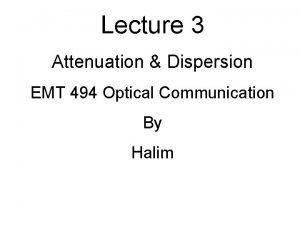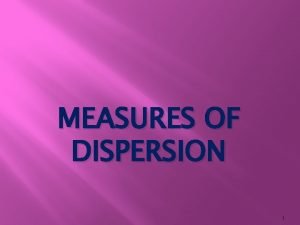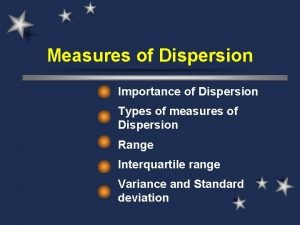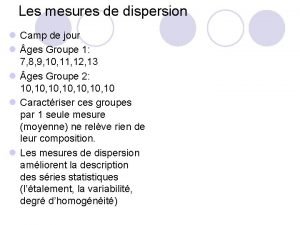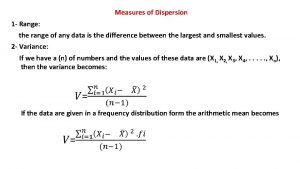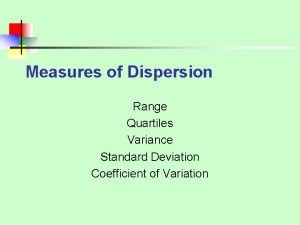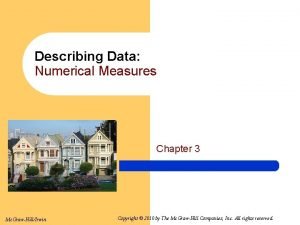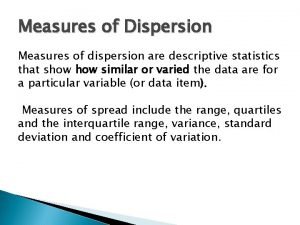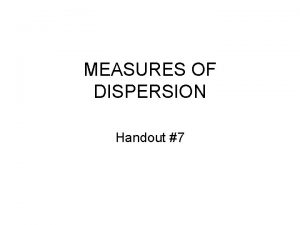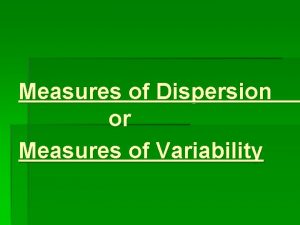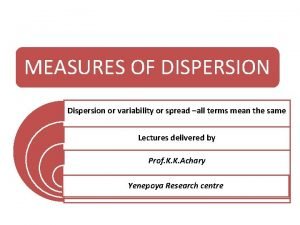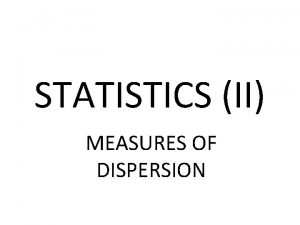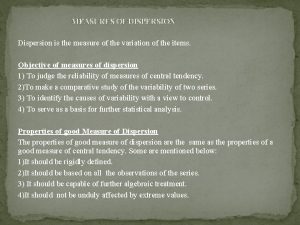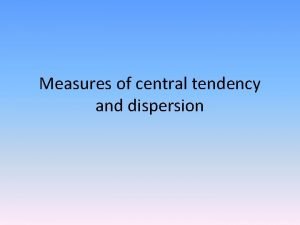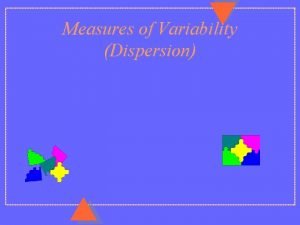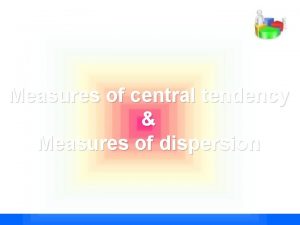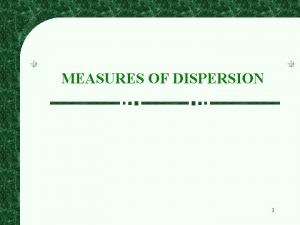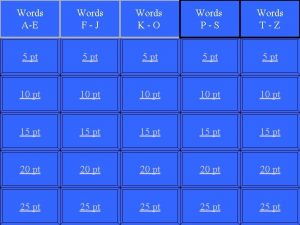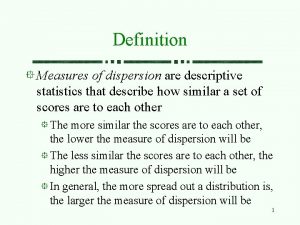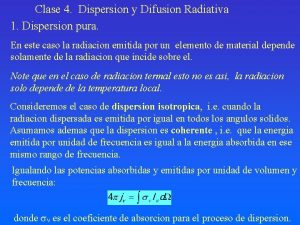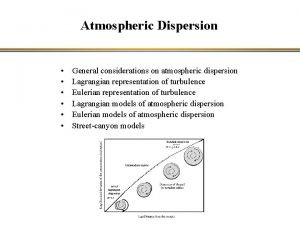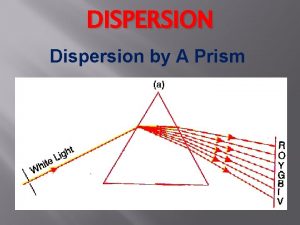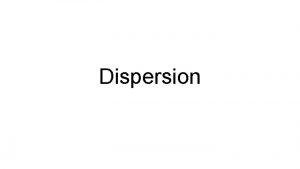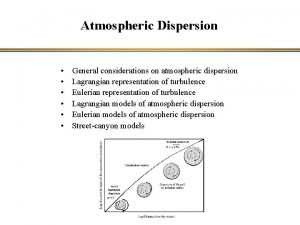MEASURES OF DISPERSION 1 DEFINITION In the words






























- Slides: 30

MEASURES OF DISPERSION 1

DEFINITION � In the words of Bowley “Dispersion is the measure of the variation of the items” According to Conar “Dispersion is a measure of the extent to which the individual items vary” 2

Definition � Measures of dispersion are descriptive statistics that describe how similar a set of scores are to each other �The more similar the scores are to each other, the lower the measure of dispersion will be �The less similar the scores are to each other, the higher the measure of dispersion will be �In general, the more spread out a distribution is, the larger the measure of dispersion will be 3

Measures of Dispersion v Which of the distributions of scores has the larger dispersion? The upper distribution has more dispersion because the scores are more spread out That is, they are less similar to each other 4

Methods of Dispersion The following are the main methods of measuring Dispersion: Ø Range Ø Interquartile Range and Quartile Deviation Ø Mean Deviation Ø Standard Deviation Ø Coefficient of Variation Ø Lorenz Curve 5

Range The Range is defined as the difference between the largest score in the set of data and the smallest score in the set of data, XL - XS Ø What is the range of the following data: 4 8 1 6 6 2 9 3 6 9? The largest score (XL) is 9; the smallest score (XS) is 1; the range is XL - XS = 9 1=8 6

When To Use the Range Ø Ø The range is used when § you have ordinal data or § you are presenting your results to people with little or no knowledge of statistics The range is rarely used in scientific work as it is fairly insensitive § It depends on only two scores in the set of data, XL and XS § Two very different sets of data can have the same range: 1 1 9 vs 1 3 5 7 9 7

Interquartile Range Interquartile range (IR) is defined as the difference of the Upper and Lower quartiles Example: Upper quartile = Q 1 Lower quartile = Q 3 Interquartile Range = Q 3 – Q 1 8

Quartile Deviation also, called semiinterquaetile range is half of the difference between the upper and lower quartiles Example: Quartile Deviation = Q 3 -Q 1 / 2 9

SIR Example What is the SIR for the data to the right? § § § 25 % of the scores are below 5 � 5 is the first quartile 25 % of the scores are above 25 � 25 is the third quartile IR = (Q 3 - Q 1) / 2 = (25 - 5) / 2 = 10 10

Coefficient of Quartile Deviation The relative measures of quartile deviation also called the Coefficient of Quartile Deviation Example: Coefficient of (Q. D)= Q 3 – Q 1 / Q 3 + Q 1 11

MEAN DEVIATION � Mean Deviation is also known as average deviation. In this case deviation taken from any average especially Mean, Median or Mode. While taking deviation we have to ignore negative items and consider all of them as positive. The formula is given below 12

MEAN DEVIATION The formula of MD is given below MD = d N (deviation taken from mean) MD = m N (deviation taken from median) MD = z N (deviation taken from mode) 13

Example of mean deviation xi fi xi. fi x-‾x x -x‾. fi 10 -15 12. 5 3 37. 5 9. 286 27. 85 15 -20 17. 5 5 87. 5 4. 286 21. 43 20 -25 22. 5 7 157. 5 . 714 4. 99 25 -30 27. 5 4 110 5. 714 22. 85 30 -35 32. 5 2 65 10. 714 21. 42 21 457. 5 30. 714 98. 57 14

solution : MD = d N mean) (deviation taken from =30. 714/21 = 1. 462 15

Standard Deviation � � When the deviate scores are squared in variance, their unit of measure is squared as well �E. g. If people’s weights are measured in pounds, then the variance of the weights would be expressed in pounds 2 (or squared pounds) Since squared units of measure are often awkward to deal with, the square root of variance is often used instead �The standard deviation is the square root of variance 16

MERITS OF STANDARD DEVIATION � � Very popular scientific measure of dispersion From SD we can calculate Skewness, Correlation etc It considers all the items of the series The squaring of deviations make them positive and the difficulty about algebraic signs which was expressed in case of mean deviation is not found here. 17

DEMERITS OF STANDARD DEVIATION � � � Calculation is difficult not as easier as Range and QD It always depends on AM Extreme items gain great importance The formula of SD is = √∑d 2 N Problem: Calculate Standard Deviation of the following series X – 40, 44, 54, 60, 62, 64, 70, 80, 96 18

Standard Deviation Standard deviation = variance Variance = standard deviation 2 S. D 19

Computational Formula � When calculating variance, it is often easier to use a computational formula which is algebraically equivalent to the definitional formula: 2 is the population variance, X is a score, is the population mean, and N is the number of 20

Computational Formula Example 21

Computational Formula Example 22

Variance � Variance is defined as the average of the square deviations: 23

What Does the Variance Formula Mean? � First, it says to subtract the mean from each of the scores �This difference is called a deviate or a deviation score �The deviate tells us how far a given score is from the typical, or average, score �Thus, the deviate is a measure of dispersion for a given score 24

What Does the Variance Formula Mean? � Why can’t we simply take the average of the deviates? That is, why isn’t variance defined as: This is not the formula for variance! 25

What Does the Variance Formula Mean? � � � One of the definitions of the mean was that it always made the sum of the scores minus the mean equal to 0 Thus, the average of the deviates must be 0 since the sum of the deviates must equal 0 To avoid this problem, statisticians square the deviate score prior to averaging them �Squaring the deviate score makes all the squared scores positive 26

What Does the Variance Formula Mean? � � � Variance is the mean of the squared deviation scores The larger the variance is, the more the scores deviate, on average, away from the mean The smaller the variance is, the less the scores deviate, on average, from the mean 27

Variance of a Sample � Because the sample mean is not a perfect estimate of the population mean, the formula for the variance of a sample is slightly different from the formula for the variance of a population: s 2 is the sample variance, X is a score, X is the sample mean, and N is the number of 28

Lorenz curve It is a graphical method of studying dispersion. Its was given by famous statistician Max o Lorenz. It has great utility in the study of degree of inequality in distribution of income and wealth 29

Thank you 30
 Dispersion phase and dispersion medium
Dispersion phase and dispersion medium Tyndall effect
Tyndall effect Material dispersion
Material dispersion Simplest measure of dispersion
Simplest measure of dispersion Mean dispersion formula
Mean dispersion formula Measures of dispersion definition
Measures of dispersion definition Importance of dispersion
Importance of dispersion Measures of dispersion
Measures of dispersion Find the median of grouped data calculator
Find the median of grouped data calculator Sample variance for grouped data
Sample variance for grouped data Measures of dispersion range
Measures of dispersion range Mean, variance, standard deviation
Mean, variance, standard deviation Measures of dispersion
Measures of dispersion Anova repeated measures
Anova repeated measures Hát kết hợp bộ gõ cơ thể
Hát kết hợp bộ gõ cơ thể Ng-html
Ng-html Bổ thể
Bổ thể Tỉ lệ cơ thể trẻ em
Tỉ lệ cơ thể trẻ em Chó sói
Chó sói Thang điểm glasgow
Thang điểm glasgow Chúa yêu trần thế
Chúa yêu trần thế Các môn thể thao bắt đầu bằng tiếng nhảy
Các môn thể thao bắt đầu bằng tiếng nhảy Thế nào là hệ số cao nhất
Thế nào là hệ số cao nhất Các châu lục và đại dương trên thế giới
Các châu lục và đại dương trên thế giới Công thức tính thế năng
Công thức tính thế năng Trời xanh đây là của chúng ta thể thơ
Trời xanh đây là của chúng ta thể thơ Mật thư tọa độ 5x5
Mật thư tọa độ 5x5 Phép trừ bù
Phép trừ bù độ dài liên kết
độ dài liên kết Các châu lục và đại dương trên thế giới
Các châu lục và đại dương trên thế giới Thơ thất ngôn tứ tuyệt đường luật
Thơ thất ngôn tứ tuyệt đường luật


